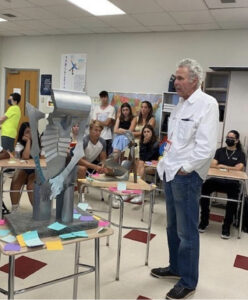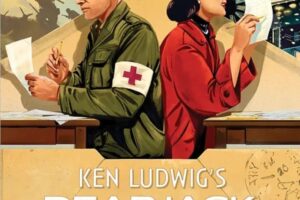
“When looking at art, you’re able to see––almost feel––a physical representation of history versus just words printed on paper in your textbook or written sources,” expressed one student in Jessica Hunsberger’s US History class, a sentiment with which many students agreed while viewing art pieces by visiting artist Howard Menken, “it’s a totally different experience––but in some ways, it almost gives a better and easier understanding of what it’s trying to represent,” added another.
On June 10th, Menken, who is Hunsberger’s father, visited two Sleepy Hollow High School US History classes to showcase the social commentary artwork from his latest exhibit, entitled “Why?”. One of the most prevalent themes throughout the history class this year has been how individuals and groups can create social change. In addition, the class has comprehensively discussed relevant theories including a writer’s purpose, a speaker’s purpose and even an artist’s purpose when citing sources.
“I did not want to whisper––I wanted to scream,” explained Menken as the students walked through and observed his gallery. Menken transported all his pieces to the school, so students had the unique opportunity to get up close and personal with all his artwork from the comfort of their own classrooms. All of his pieces visually depict and speak to tragic historic events or enduring issues such as the Holocaust, the 2022 Russian invasion of Ukraine, and the Trail of Tears.
“I thought that Mr. Menken’s piece about Matthew Shepard was really impactful,” said 11th grade student Natalie. The piece in question was an emotionally graphic depiction of the murder of the gay university student who was left to die tied to a fence. This 1998 hate crime is best known for the trial, which brought national and international attention to hate crime legislation at both the state and federal level.
“I wasn’t aware of this specific event, and I don’t think many of my classmates were either. It was interesting to see someone of his generation know so much about modern-day issues and see it reflected so emotionally in his artwork,” elaborated Natalie.
As they observed they spoke in small groups, continuing with conversations about the pieces, what they learned, their personal interpretations, and how they impacted them. They even had the opportunity to help assign names to some of Menken’s pieces for his exhibit. For example, after significant thought about the topic and the way the art piece presented it, the students came up with the name “Freedom Behind Bars” for one of Menken’s pieces about immigration.
However, during the reflection and naming process, students realized rather quickly that, while their initial feelings about how some messages ring clearer through art still felt somewhat true, art has the potential to be interpreted in different ways––as indicated by the students’ various interpretations written on Post-it notes surrounding Mr. Menken’s pieces. This experience offered the students a firsthand look at the benefits of artistic perspective as well as its shortcomings, emphasizing the value of balance between written, spoken and artistic perspectives in the interpretation of history and current events.
“I believe this experience not only showed how creativity is an important outlet for us when we are feeling disturbed or frustrated with events in the world, but it also helped show the students how individuals can educate and effect change through their artwork,” Hunsberger shared.
“My hope is that this experience inspires students to take informed action on pressing issues we face in our society.”







